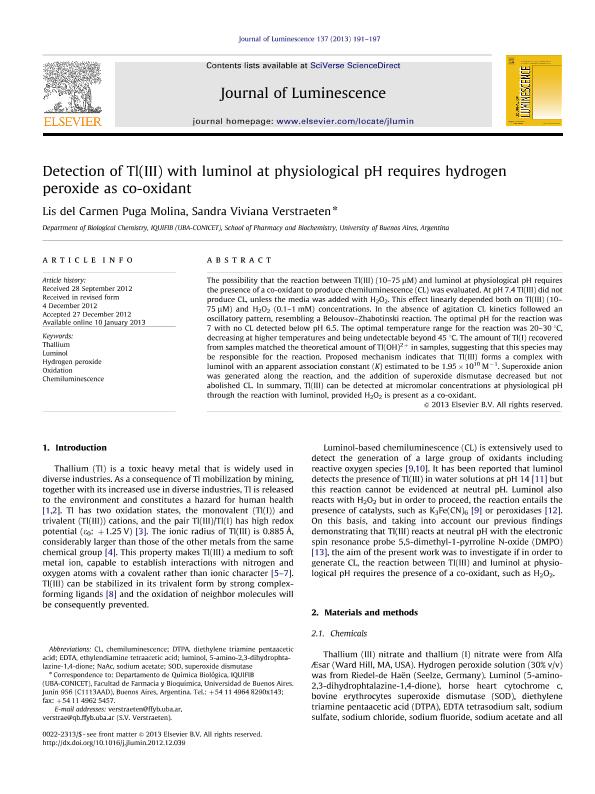Mostrar el registro sencillo del ítem
dc.contributor.author
Puga Molina, Lis del Carmen
dc.contributor.author
Verstraeten, Sandra Viviana

dc.date.available
2016-02-29T18:58:48Z
dc.date.issued
2013-05
dc.identifier.citation
Puga Molina, Lis del Carmen; Verstraeten, Sandra Viviana; Detection of Tl(III) with luminol at physiological pH requires hydrogen peroxide as co-oxidant; Elsevier Science; Journal Of Luminescence; 137; 5-2013; 191-197
dc.identifier.issn
0022-2313
dc.identifier.uri
http://hdl.handle.net/11336/4528
dc.description.abstract
The possibility that the reaction between Tl(III) (10–75 μM) and luminol at physiological pH requires the presence of a co-oxidant to produce chemiluminescence (CL) was evaluated. At pH 7.4 Tl(III) did not produce CL, unless the media was added with H2O2. This effect linearly depended both on Tl(III) (10–75 μM) and H2O2 (0.1–1 mM) concentrations. In the absence of agitation CL kinetics followed an oscillatory pattern, resembling a Belousov–Zhabotinski reaction. The optimal pH for the reaction was 7 with no CL detected below pH 6.5. The optimal temperature range for the reaction was 20–30 °C, decreasing at higher temperatures and being undetectable beyond 45 °C. The amount of Tl(I) recovered from samples matched the theoretical amount of Tl(OH)2+ in samples, suggesting that this species may be responsible for the reaction. Proposed mechanism indicates that Tl(III) forms a complex with luminol with an apparent association constant (K) estimated to be 1.95×1010 M−1. Superoxide anion was generated along the reaction, and the addition of superoxide dismutase decreased but not abolished CL. In summary, Tl(III) can be detected at micromolar concentrations at physiological pH through the reaction with luminol, provided H2O2 is present as a co-oxidant.
dc.format
application/pdf
dc.language.iso
eng
dc.publisher
Elsevier Science

dc.rights
info:eu-repo/semantics/openAccess
dc.rights.uri
https://creativecommons.org/licenses/by-nc-nd/2.5/ar/
dc.subject
Thallium
dc.subject
Luminol
dc.subject
Hydrogen Peroxide
dc.subject
Chemiluminescence
dc.subject.classification
Química Analítica

dc.subject.classification
Ciencias Químicas

dc.subject.classification
CIENCIAS NATURALES Y EXACTAS

dc.title
Detection of Tl(III) with luminol at physiological pH requires hydrogen peroxide as co-oxidant
dc.type
info:eu-repo/semantics/article
dc.type
info:ar-repo/semantics/artículo
dc.type
info:eu-repo/semantics/publishedVersion
dc.date.updated
2016-03-30 10:35:44.97925-03
dc.journal.volume
137
dc.journal.pagination
191-197
dc.journal.pais
Países Bajos

dc.journal.ciudad
Amsterdam
dc.description.fil
Fil: Puga Molina, Lis del Carmen. Universidad de Buenos Aires. Facultad de Farmacia y Bioquímica. Departamento de Química Biológica; Argentina. Consejo Nacional de Investigaciones Científicas y Técnicas. Oficina de Coordinación Administrativa Houssay. Instituto de Química y Fisicoquímica Biológicas; Argentina
dc.description.fil
Fil: Verstraeten, Sandra Viviana. Universidad de Buenos Aires. Facultad de Farmacia y Bioquímica. Departamento de Química Biológica; Argentina. Consejo Nacional de Investigaciones Científicas y Técnicas. Oficina de Coordinación Administrativa Houssay. Instituto de Química y Fisicoquímica Biológicas; Argentina
dc.journal.title
Journal Of Luminescence

dc.relation.alternativeid
info:eu-repo/semantics/altIdentifier/doi/http://dx.doi.org/10.1016/j.jlumin.2012.12.039
dc.relation.alternativeid
info:eu-repo/semantics/altIdentifier/url/http://www.sciencedirect.com/science/article/pii/S0022231312007594
dc.relation.alternativeid
info:eu-repo/semantics/altIdentifier/issn/0022-2313
Archivos asociados
